Related Research Articles

Michael Polanyi was a Hungarian-British polymath, who made important theoretical contributions to physical chemistry, economics, and philosophy. He argued that positivism supplies an imperfect account of knowing as no observer is perfectly impartial.

Dudley Robert Herschbach is an American chemist at Harvard University. He won the 1986 Nobel Prize in Chemistry jointly with Yuan T. Lee and John C. Polanyi "for their contributions concerning the dynamics of chemical elementary processes". Herschbach and Lee specifically worked with molecular beams, performing crossed molecular beam experiments that enabled a detailed molecular-level understanding of many elementary reaction processes. Herschbach is a member of the Board of Sponsors of the Bulletin of the Atomic Scientists.
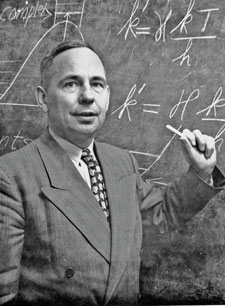
Henry Eyring was a Mexico-born United States theoretical chemist whose primary contribution was in the study of chemical reaction rates and intermediates. Eyring developed the Absolute Rate Theory or Transition state theory of chemical reactions, connecting the fields of chemistry and physics through atomic theory, quantum theory, and statistical mechanics.
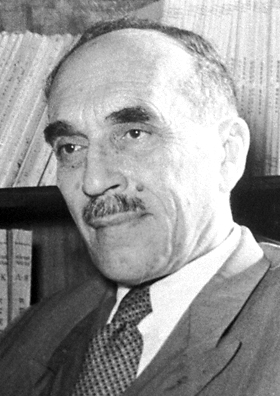
Nikolay Nikolayevich Semyonov, was a Soviet physicist and chemist. Semyonov was awarded the 1956 Nobel Prize in Chemistry for his work on the mechanism of chemical transformation.
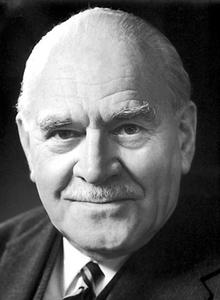
Ronald George Wreyford Norrish FRS was a British chemist who was awarded the Nobel Prize in Chemistry in 1967.

John Charles Polanyi is a German-born Canadian chemist. He was awarded the 1986 Nobel Prize in Chemistry for his research in chemical kinetics.
George Claude Pimentel was the inventor of the chemical laser. He also developed the technique of matrix isolation in low-temperature chemistry. In theoretical chemistry, he proposed the three-center four-electron bond which is now accepted as the best simple model of hypervalent molecules. In the late 1960s, Pimentel led the University of California team that designed the infrared spectrometer for the Mars Mariner 6 and 7 missions that analyzed the surface and atmosphere of Mars.

Sir Cyril Norman Hinshelwood was a British physical chemist and expert in chemical kinetics. His work in reaction mechanisms earned the 1956 Nobel Prize in chemistry.

Richard Neil Zare is the Marguerite Blake Wilbur Professor in Natural Science and a Professor of Chemistry at Stanford University. Throughout his career, Zare has made a considerable impact in physical chemistry and analytical chemistry, particularly through the development of laser-induced fluorescence (LIF) and the study of chemical reactions at the molecular and nanoscale level. LIF is an extremely sensitive technique with applications ranging from analytical chemistry and molecular biology to astrophysics. One of its applications was the sequencing of the human genome.
Keith James Laidler, born in England, was notable as a pioneer in chemical kinetics and authority on the physical chemistry of enzymes.
Marjorie Constance Caserio was an English chemist. In 1975, she was awarded the Garvan Medal by the American Chemical Society.

Donald Gene Truhlar is an American scientist working in theoretical and computational chemistry and chemical physics with special emphases on quantum mechanics and chemical dynamics.
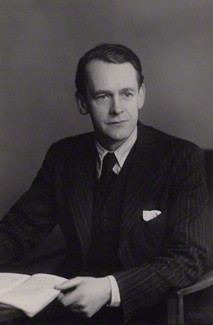
Meredith Gwynne Evans, FRS was a British physical chemist, who made important theoretical contributions in the study of chemical reaction rates and reaction mechanisms. Together with Henry Eyring and Michael Polanyi, Meredith Gwynne Evans is one of the founders of the transition state theory.
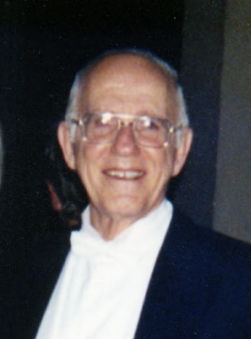
(Benton) Seymour Rabinovitch was a professor of chemistry at the University of Washington in Seattle, whose research including developing measurements for the efficiency with which energy is transferred between molecules in gas phase chemical reactions. Rabinovitch was an editor of the Annual Review of Physical Chemistry and of the Journal of the American Chemical Society.
Yang Shao-Horn is a Chinese American scholar, Professor of Mechanical Engineering and Materials Science and Engineering and a member of Research Laboratory of Electronics at the Massachusetts Institute of Technology. She is known for research on understanding and controlling of processes for storing electrons in chemical bonds towards zero-carbon energy and chemicals.

James Robert Durrant is a British photochemist. He is a professor of photochemistry at Imperial College London and Sêr Cymru Solar Professor at Swansea University. He serves as director of the centre for plastic electronics (CPE).

Ian William Murison Smith was a chemist who served as a research fellow and lecturer in the Department of Chemistry, University of Cambridge from 1963 to 1985 and Professor of Chemistry at the University of Birmingham from 1985 to 2002.
Christopher Barner-Kowollik FAA, FQA, FRSC, FRACI is an Australian Research Council (ARC) Laureate Fellow, the Senior Deputy Vice-Chancellor and Vice-President (Research) of the Queensland University of Technology (QUT) and Distinguished Professor within the School of Chemistry and Physics at the Queensland University of Technology (QUT) in Brisbane. He is the Editor-in-Chief of the Royal Society of Chemistry (RSC) journal Polymer Chemistry, a principal investigator within the Soft Matter Materials Laboratory at QUT and associate research group leader at the Karlsruhe Institute of Technology (KIT).
Akkihebbal Ramaiah (Ravi) Ravishankara ForMemRS FAAAS FRSC is a scientist specializing in Chemistry and Atmospheric Sciences, and University Distinguished Professor in the Departments of Chemistry and Atmospheric Sciences at Colorado State University, Fort Collins.
John Philip Simons is a British physical chemist known for his research in photochemistry and photophysics, molecular reaction dynamics and the spectroscopy of biological molecules. He was professor of physical chemistry at the University of Nottingham (1981–93) and Dr. Lee's Professor of Chemistry at the University of Oxford (1993–99).
References
- ↑ "Gas Kinetics Awards". The Royal Society of Chemistry. Retrieved 11 September 2018.
- ↑ "25th International Symposium on Gas Kinetics". Sciencesconf.org. Retrieved 11 September 2018.
- ↑ https://gk2022.sciencesconf.org/ [ bare URL ]
- ↑ "Argonne chemist receives Royal Society of Chemistry medal". Argonne National Laboratory. 27 November 2019. Retrieved 2 September 2020.
- ↑ Pilling, Michael J.; Robertson, Struan H.; Seakins, Paul W. (1995). "Elementary radical reactions and autoignition". Journal of the Chemical Society, Faraday Transactions. Royal Society of Chemistry (RSC). 91 (23): 4179. doi:10.1039/ft9959104179. ISSN 0956-5000.
- ↑ "Curriculum Vitae of Jürgen Troe". The Journal of Physical Chemistry A. American Chemical Society (ACS). 110 (9): 2835. 2006. Bibcode:2006JPCA..110.2835.. doi: 10.1021/jp068005r . ISSN 1089-5639. PMID 16509602.
- ↑ Golde, Michael F. (13 September 1919). Biographical Memoirs: V.66 (1995) Chapter: Frederick Kaufman. The National Academies Press. doi:10.17226/4961. ISBN 978-0-309-05237-5 . Retrieved 11 September 2018.